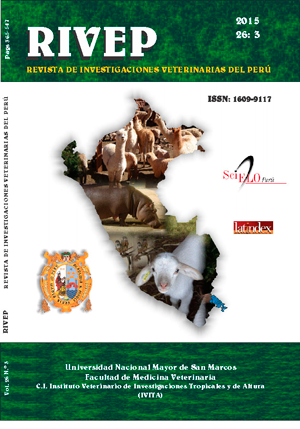Alternative cryoprotectans suitable for a slow freezing method of epididymal spermatozoa of alpaca (Vicugna pacos)
DOI:
https://doi.org/10.15381/rivep.v26i3.11185Keywords:
alpaca, sperm, cryopreservation, dimethylacetamide, dimethylsulfoxideAbstract
The objective of this study was to use alternative cryoprotectans suitable for freezing epididymal spermatozoa of alpaca (Vicugna pacos) in a slow freezing method. Epididymides obtained in the slaughterhouse of Huancavelica city were transported at 4 °C in saline solution to the laboratory in Lima, Peru. The sperm cells were extracted from the epididymis and incubated in HAMF10 medium. The Tes-Tris-Yolk-Citrate medium was used and supplemented with the cryoprotectants dimethyl sulfoxide (Me2SO4) at 0.5, 0.25 and 0.125M concentrations, and dimethylacetamide (DMA) at 0.75, 0.385 and 0.18M concentrations, and compared with a control group cryopreserved with glycerol 0.6M. Motility, viability and integrity of membrane before and after freezing were assessed. The results showed a better viability and membrane integrity post-freezing when using DMA 0.375M (p<0.05). Motility was better with Me2SO4 0.25 and 05M and DMA 0.375 and 0.75M (p<0.05).Downloads
Downloads
Published
Issue
Section
License
Copyright (c) 2015 Nadia Canorio Pariona, Fernando Paredes Arnedo, Martha Valdivia Cuya

This work is licensed under a Creative Commons Attribution-NonCommercial-ShareAlike 4.0 International License.
AUTHORS RETAIN THEIR RIGHTS:
a. Authors retain their trade mark rights and patent, and also on any process or procedure described in the article.
b. Authors retain their right to share, copy, distribute, perform and publicly communicate their article (eg, to place their article in an institutional repository or publish it in a book), with an acknowledgment of its initial publication in the Revista de Investigaciones Veterinarias del Perú (RIVEP).
c. Authors retain theirs right to make a subsequent publication of their work, to use the article or any part thereof (eg a compilation of his papers, lecture notes, thesis, or a book), always indicating the source of publication (the originator of the work, journal, volume, number and date).










